When Bonding Primer is a Must Before Painting
Never heard of bonding primer? It is the BEST primer and a must when painting over many surfaces.
Bonding primer was something that I never knew about, until worked for Valspar and did so for 5 years.
When I was asking about painting over a stained wood piece of furniture, my co-worker who managed the primer categories said bonding primer was a must.
Fast forward 10 years and more projects than I can count, Valspar Bonding primer is a must for all of my furniture and cabinet paint projects!
All-Purpose Primers
First off, no paint is a primer too! So a Paint + Primer tag on a paint can is a marketing gimmick…I am going to explain.
The first coat of paint acts as a primer to prime the surface for the 2nd coat of paint. Nothing more!
A general primer’s job is to prep the surface for the topcoat. That’s it.
An all-purpose primer is great for drywall or going over the same type and color of paint on a variety of jobs.
I always recommend that you should save yourself money, when transitioning from a dark to a light color, and start with a basic all-purpose primer first.
When I painted a room red and regretted it, I decided I wanted a tan paint.

I would have had to apply 4 or more coats of paint in that example and instead applied one coat of all-purpose primer FIRST to knock down the red.
Not only did I use an all-purpose primer first, but I had it tinted a shade of gray to more quickly cover the red paint underneath.
That saved me time and money, so it took only 2 coats of paint.
Why is that important?
A general primer is MUCH CHEAPER per gallon than paint.
When you should use an all-purpose primer:
- To cover and block stains on drywall: crayon, water, grease, pen
- During extreme color changes: light to darker or the reverse
- Changing from an oil to a latex water-based paint
- Moving from a high-gloss sheen to a lower sheen
- Prepping bare wood or metal for paint
It cannot be used to cover mold or mildew. Those must be removed/killed with bleach and water prior to applying primer.
The water in the primer will re-activate the mold growth, so get rid of it first!
Any time a primer says “all-purpose” or “multi-use” realize it’s a general primer and may not be perfect for your specific need.
When You Need a Bonding Primer
Now what you came here to learn, which is when do I need to step up and pay extra for a bonding primer?
If you are a person who likes to up-cycle stained cabinets and furniture, bonding primer is a MUST!
Even with chalk paint it’s a great idea on an old stained piece of furniture to use a bonding primer first.
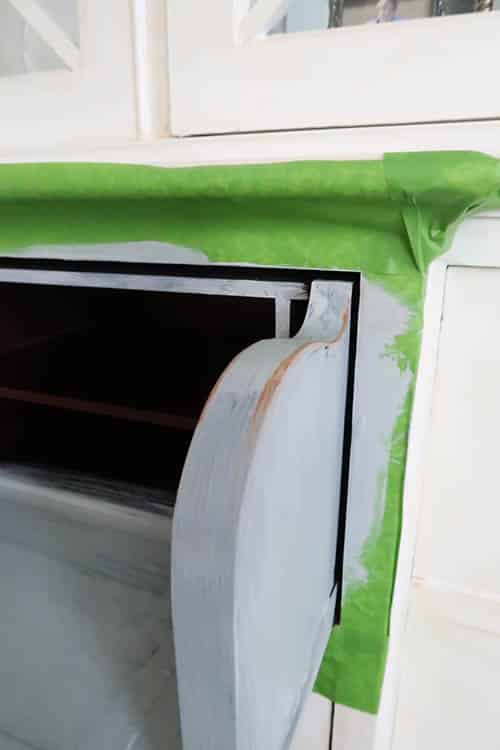
Why? It’s that darn thing called, bleed through or those darn brown streaks that come through the paint.
If you don’t spot test first, you may spend a lot of time painting and all of a sudden brown streaks will show through.
People have even reached out to me and said when they applied a clear coat over the paint it stimulated the bleed through.
Want to know how-to stop paint bleed through, AFTER it has happened?
READ: MY SOLUTION TO STOP CHALK PAINT BLEED THROUGH
It’s very upsetting to have to redo hours of work!
Projects When Bonding Primer is a Must:
- Non-porous “shiny” surfaces like tile, metal, mirror and glass.
- When stain blocking activated by water is a concern: tannin and wood stain bleed.
- For slick surface adhesion to oil and water based topcoats: polyurethane, varnish, and shellac
- Plastic, PVC and Resin
- Sealing knotty wood surfaces
- Laminated or Thermofoil surfaces
Guess what this means?
Pin It for Later!
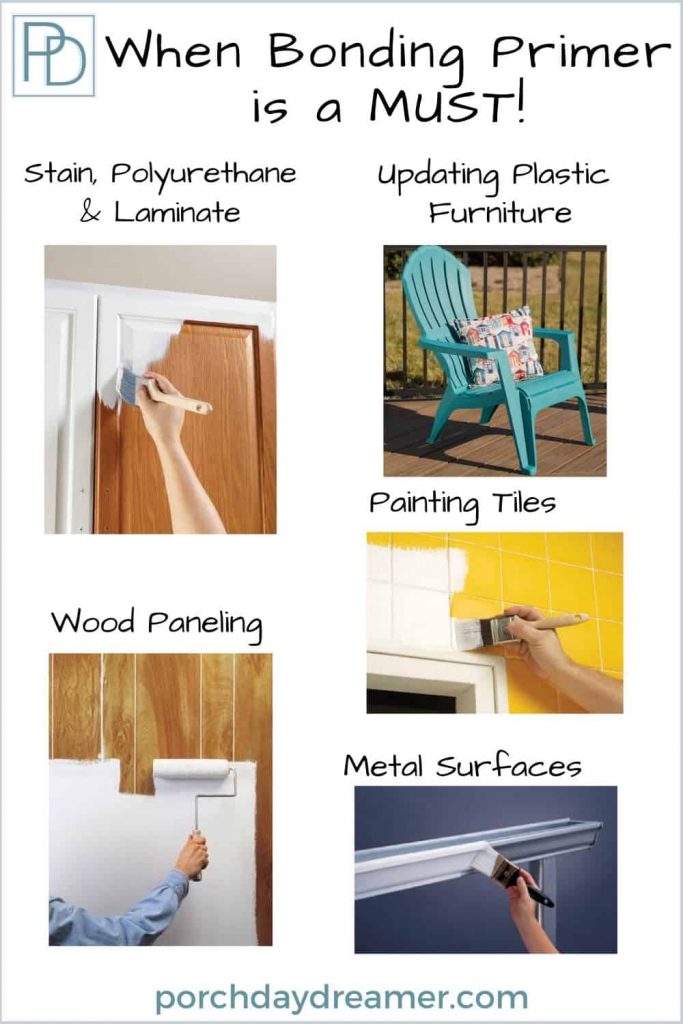
YOU DON’T HAVE TO SAND POLYURETHANE BEFORE PAINTING IF YOU USE A BONDING PRIMER!
Bonding primer is my go to when painting cabinets and furniture that have been stained and polyurethaned.
Here is a whole blog post to show you all of the projects, including a large stained armoire.
You can read all about how I transformed this armoire here: Paint Sprayer Turned a Dreaded Project into the Best Ever!
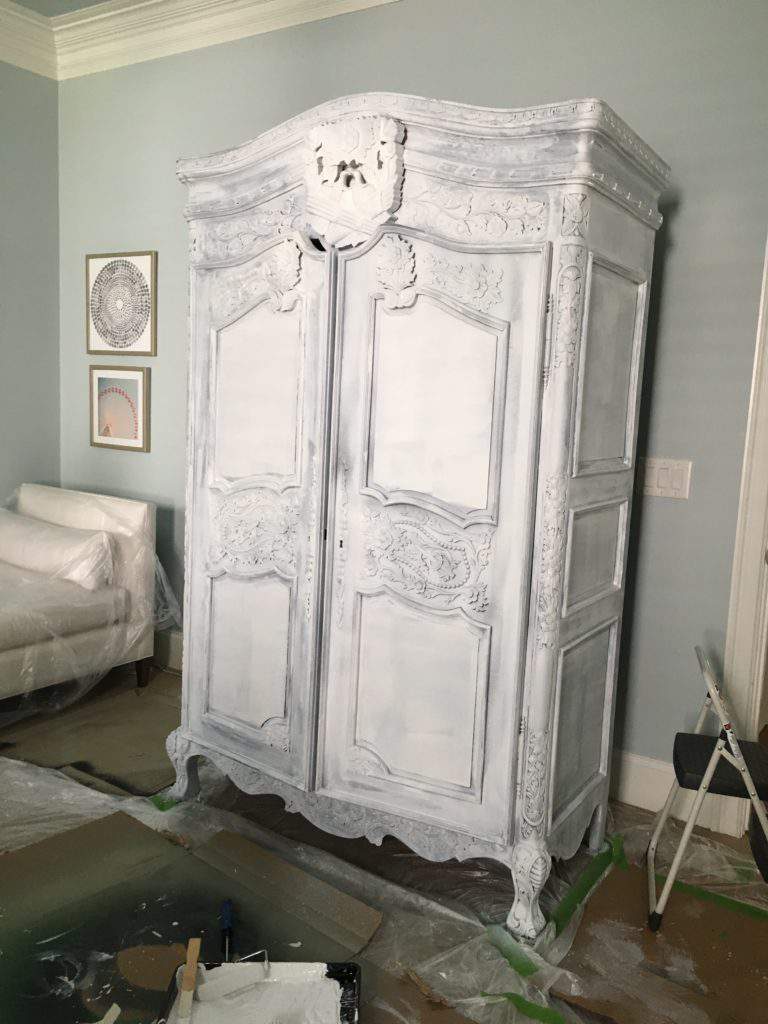
Plus I just used a bonding primer to paint stair risers too!
When I tried a liquid sanding agent this is what happened…a disaster, when the paint pulled away as I removed the painter’s tape.
I veered off my normal course of typically starting with a bonding primer, but I wasn’t upset because it’s aways good to try new methods.
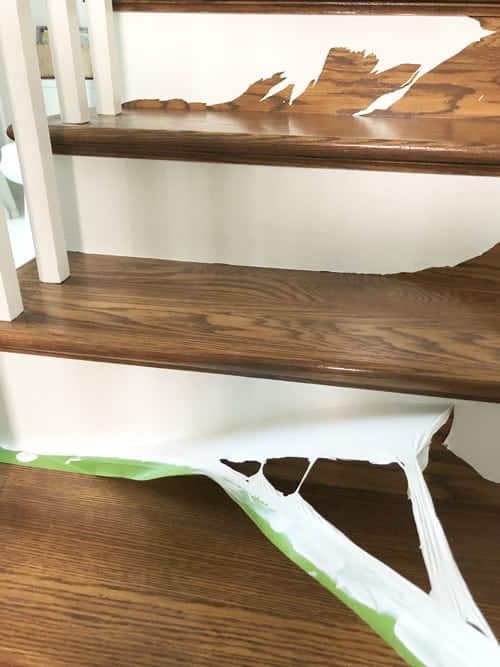
You can read all about how to PROPERLY prepare stairs for painting here: How-To Prep and Paint Stained Stairs White
Bonding Primer did what it was supposed to do and the stair risers haven’t had one chip in the paint, after vacuuming them and 6 months of foot traffic.
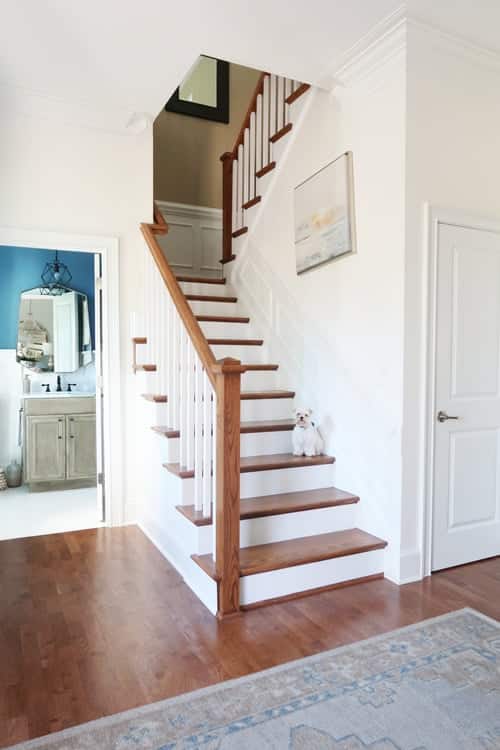
To me that is the best testimonial or maybe it’s my nightstands because I’ve had no issues with the horizontal surface and chipping.
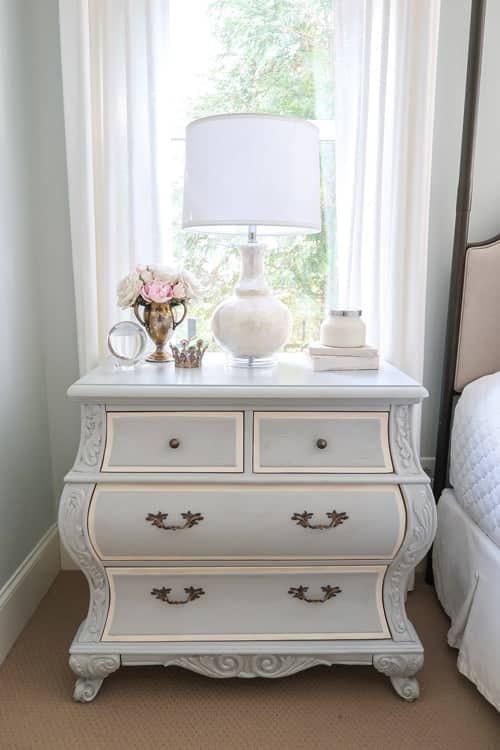
Or you can use a bonding primer to paint plastic!
See how I transformed my outdoor resin wicker furniture from a dark brown plastic to a beautiful driftwood.
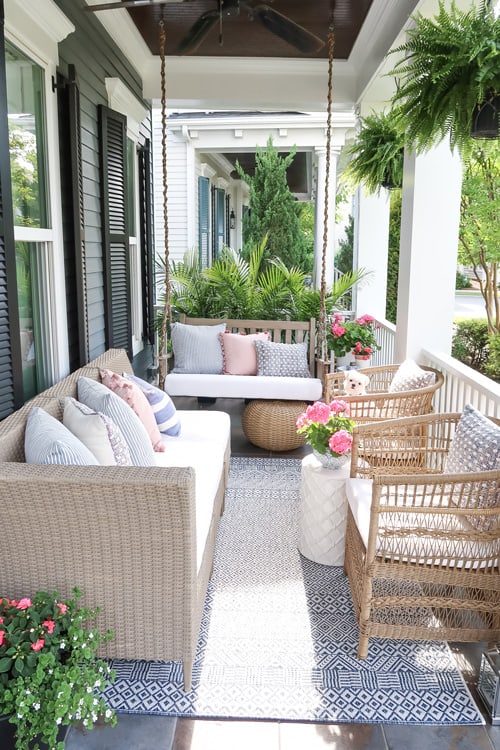
Here is the full tutorial: Spray Paint Outdoor Resin Wicker Furniture!
Where bonding primer is critical is when you are painting cabinets!
Every cabinet painting project in my home has ALWAYS started with a coat of bonding primer to ensure great adhesion, so the paint doesn’t chip off in day to day use.
I’ve painted cabinets in the following rooms moving from a dark stain to white or a color: office, bathroom, and powder room.
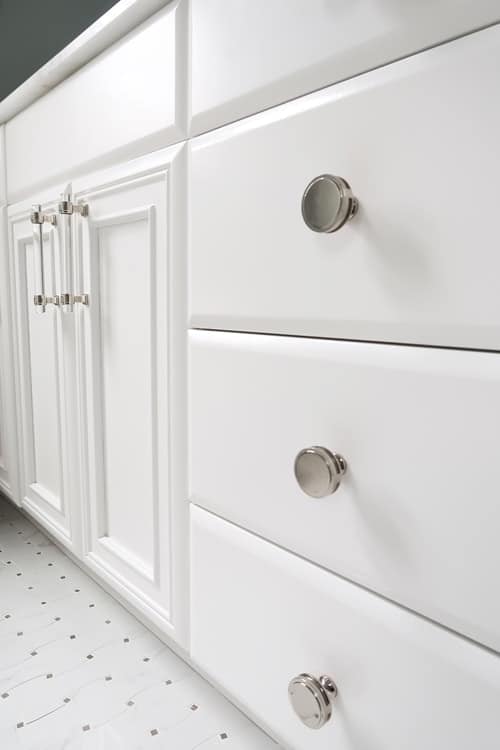
Want to learn more about painting cabinets? Here are some helpful posts:
- REVIEW: New Formula Valspar Cabinet and Furniture Enamel or The Best Cabinet Paint You Need to Know About
- NO-SAND Method to Painting Kitchen Cabinets
- How-to Paint Cabinets and Get a Smooth Finish
- Hand Painting or Spraying Cabinets: What is Better?
Hopefully, now you have an understanding of why a bonding primer is critical for certain hard to paint surfaces.
I seriously ALWAYS keep a can on hand, so it’s ready for my next painting project because I do them so often.
There are multiple brands and options for bonding primers that I’ll list here:
- Valspar Bonding Primer
- Sherwin Williams Extreme Bond Primer
- Kilz Adhesion Primer
- Benjamin Moore Stix Primer
I liked this more technical post relating bonding primer to peanut butter on bread as the glue: The How’s and Why’s of Bonding Primer
My FAVORITE and go to is always Valspar Bonding Primer…it’s never let me down!
You can read about all of the projects where I’ve used it here: No! You Do Not Have to Sand Before Painting Over Stain
People email me a lot of questions about Valspar Bonding Primer, so I’ll address them here in one spot!
Tips applying Valspar Bonding Primer:
- This stuff is THICK and can appear chunky in the can, so stir it thoroughly.
- It only takes one coat and can be painted over in one hour.
- Primer isn’t meant to cover, but coat so you will see the surface below it.
- Apply with a nylon/polyester brush, foam roller, or 3/8 inch nap roller.
- To test for primer adhesion before painting, don’t scratch but instead apply a small piece of painter’s tape to see if it pulls off the primer.
- Valspar Bonding Primer can be sprayed! I get asked that a lot.
- When spraying, VBP doesn’t need to be thinned nor is it recommended but you may want to strain it.
- Once fully dry, you can lightly sand off any imperfections, but it’s not necessary to sand.
Always PREP your surfaces by cleaning and sanding flaking or failing paint prior to priming.
So you believe it’s sprayable, here I am spraying and did a ton of furniture and cabinets this way:
A helpful post now that you have seen me use a paint sprayer!
If you are using a paint sprayer, please remember the consistency is much thicker than a paint so the settings need to be modified.
You will need more force to push the primer, so more air pressure. Please read the manufacturer’s instructions.
Literally, with a little bonding primer just about any surface that is stable can be painted!

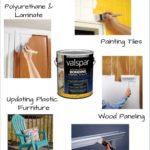

using valspar bonding primer as suggested over old oil based paint with glossy finish that has been mildly sanded and TSP cleaned. I tested with tape test and all good. But i then picked at it and I could get it off picking at it and some light scrapping. this was after 4 hours. am i not giving it enough time?
I sent you an email to focus on the peanut butter on bread analogy in this post. Don’t scratch at the primer. It works WITH the paint to adhere it to the door. One doesn’t work without the other 🙂
hey tracey, hope i can get your advice. i painted a floor with porch and floor latex paint, then did a polycrylic clear coat satin finish. i messed up the clear coat badly and there are white roller streaks everywhere, so ive decided to re-paint. i bought concrete primer to go over the clear coat, mainly because it was the only “floor” primer i could find. then i found something about adhesive/bonding primer. do you think i need a bonding primer before adding another coat of paint, or will the concrete primer be fine?
Hi, David! This is a problem I’ve never had experience with so I don’t want to advise you incorrectly. Porch and Floor paint doesn’t require a topcoat, so that’s likely why you had issues.
Hi Tracy, I am painting my kitchen cabinets and I hope you give me the answer I want to hear lol… I will be using the Valspar Cabinet & Furniture oil-enriched enamel.
My cabinets are MDF that were previously vinyl wrapped. I was told by a Lowe’s employee that a water based primer would warp MDF since it absorbs water quicker than wood. The employee recommended Kilz original oil based primer and I primed half the cabinets before reading your post about primers. My question is, will the Vaspar. Furniture paint adhere to the oil base primer and if not what product can I use on the cabinets that I already primed and the ones that are still bared without damaging them.
Thank you in advance for your help
Hey, Marcus! My answer is based on doing research for you and not knowing from my own experience. My garage has an MDF counter and I saw how much water it absorbed, so the struggle is real and why I used contact paper to cover it! What I remember from training and doing some more digging is that you can apply latex water based paint over an oil based primer. My advice is to always test a small area first and let it dry overnight 🙂
I need to paint my ceilings. They are oil based paint and are stained with nicotine. How do I cover them? They are 9 ft and would be almost impossible to clean first. Is there a primer that would cover them?
Bonding primer is a stain blocking and sealing primer as well so it should do the job. Sorry, I am not around smokers so I haven’t tackled this problem directly.
Hello, I am wondering if you have any direction regarding whether or not the bonding primer is a viable option on bathroom laminate flooring. I would like to paint it (followed by coats of poly, rest assured) and am trying to discern whether or not bonding primer is a viable option to substitute sanding the floor first. Thank you.
Eileen
I haven’t used it on a floor and laminate is the hardest surface. You would have to sand and then prime. Another idea…have you seen the peel and stick floor tiles? That may be a little more expensive, but will be a huge change! Here is an affiliate link to investigate and there are so many options! https://amzn.to/3eJXFFq and they are only $15 for 10 sq. ft.
I’m painting over enamel paint on paneling & woodwork with latex using the valspar bonding primer. Do I was all down with TSP or something else first? I had originally lightly sanded all & painted. Paint did not stick. I’ve peeled & scraped all off to start over.
OH gosh how frustrating! If you have sanded down smooth and cleaned really well with water removing all dust, you should be safe to prime. Another option is to wipe down with a liquid deglosser before priming to be safe. That may help to get in the nooks and crannies to ensure even adhesion 🙂
Would bonding primer be appropriate for aluminum house siding?
Sorry, I am not well versed on painting aluminum siding. I’d do some searching to see if you need a direct to metal primer. I’ve seen where latex exterior paints are recommended, but do your homework!
Great article! I want to use porch and floor paint to paint my polyed stair treads. Are you saying that bonding primer is ok to use here without sanding first? Hopefully that’s what you’re saying! Thanks in advance!
Leah, I would read this post first and I was paint stair risers not treads. A little bit of sanding will help and then bonding primer…https://porchdaydreamer.com/how-to-paint-stair-risers-white/
Hi! I just painted two coats of the valspar cabinet and furniture enamel onto a bare wood buffet. It is pine and soaked up two coats of the enamel paint so far! And it still has patchiness to the finish bc the virgin wood is a total sponge! I JUST realized “I should have primed!!” I landed here and I’m totally kicking myself. What should I do?! Keep painting with the enamel paint until it reaches the sheen I want? Or stop, do a coat of primer on top of the enamel coats i have so far, and then re-do the enamel. Any advice?
Oh gosh! I’m so sorry to hear that, but good for you to realize you needed to do something different. Gosh, you are not going to like my answer because it’s more work. Yes, I’d go ahead to apply a coat of bonding primer over what you’ve already painted. I had a PROFESSIONAL not prime my new pine fence and pine will create tannin bleed which are brown streaks through the paint. The only way for me to fix it is to prime and paint those boards, so I feel you! I’m worried you will get bleed through in the weeks ahead as the paint cures, so to avoid it prime and paint again…good luck and glad you found me 🙂
Hey! I’m painting my kitchen cabinets now! I’m currently working on applying the Valspar bonding primer, and was wondering if once I apply the Valspar Cabinet enamel, if I need to lightly sand in between coats? (I purchased the semi-gloss, I’m not sure if the finish matters as far as sanding goes. I know typically the higher the gloss, the more likely imperfections will show up. So I’m wondering if lightly sanding will help.)
Hey, Stephanie! I’ll sometimes sand the primer if some areas aren’t as smooth as I would like. However, I’ve never sanded between coats of the Valspar Cabinet Enamel. The best way to avoid imperfections is to use a foam roller and “strike off” each coat. That means the last step is running your roller top to bottom in a single stroke while the paint is still wet on the cabinet doors and across on the cabinet drawers. I NEED to make a video of this 😉
Perfect! I hadn’t seen anything about sanding between coats of the cabinet enamel but had for some other paints, so I wasn’t sure. I had already planned on striking off with a roller, so I’ll just do that. 😊 Thanks!
Hi, I am currently painting my kitchen cabinets. I bought the Valspar bonding primer and brushed it on the old laquer finished cabinets. The primer is chipping and peeling off with every little touch. The paint guy at Lowe’s says that’s unheard of. What to do?
Did you clean the cabinets? If they are greasy, then nothing will stick. Also, the proper way to test adhesion isn’t to scratch the primer with your nail. You can lightly score it and apply painters tape over the X and pull up. If the primer is coming off in sheets, then it didn’t adhere. You may need to sand down and start again. Bonding primer acts like peanut butter to make the paint stick.
Hi there. If I used a primer on my furniture that is not a bonding primer, can I put the bonding primer on top of the regular primer? I’m having an issue with the base coat of my paint peeling off.
If the base coast is peeling, then every paint layer on top of it is going to fail too. Unfortunately, the only way to prepare the surface is to sand down the peeling paint to bare wood. Then prime and paint.
Hi, Tracey. Such a godsend I found your site! We have moved into a log cabin that is 36 years old. The front and back porch floors are painted in a very dark green – multiple coats over multiple years, I am sure. We can’t tell if the paint used was oil or water based. It’s in very good shape, but they are both huge and I just can’t see us sanding such large surfaces without renting a machine or having a professional do it. I believe I read that the bonding primer can be used over either oil or water-based paint, and since the porch floors don’t have to be repaired, would it be possible to use the bonding primer without sanding and still have the water-based, lighter in color paint we have chosen have good adherence over time with foot traffic? Thanks so much! Ann
Hey, Ann! I’m so glad you found me too. Floors are another animal and require different care and products. I’m going to link the Valspar Floor paint and there specific instructions on how to prep the floor. Any dirt or loose paint underneath a new coating will lead to peeling and failure, so proper prep is SO important. You need a more durable paint for the floor too, so this one dries to a harder finish. Plus it can be tinted into different colors and comes in a variety of sheens too. https://www.valsparpaint.com/en/find-the-right-product/exterior/paint/latex-porch-floor-paint.html
Can this be used on an outdoor mini barn! The front of mine has splits/paint chipping off. Not sure what to use before painting it. Tks! !
Sorry, but anytime something is chipping and has splits you need to sand down thoroughly and then use the primer.
Hi Tracey,
Thank you for the wonderful explanation on bonding primer and the recommendation for using Valspar Cabinet Enamel. I am working on my very first painted furniture project (a table I bought of Craigslist 5 years ago that I am finally getting around to painting since the whole world is shut down due to the coronavirus) and it’s turning out beautifully! Do you recommend any type of sealer or polyurethane on it after it’s done curing? I did two coats of the bonding primer and two coats of the cabinet enamel. The coverage is excellent, but this piece is going to get a lot of use since it’s my kitchen table and I have rough little boys. I would love your thought on what I should do next!
Hi! Alison, good for you! I normally say you don’t need a top coat on Valspar Cabinet Enamel BUT you have boys LOL. I painted my son’s bedroom furniture long ago and applied 3 coats of a water based polyurethane and it NEVER chipped. Yes, I would protect the top of the table. Chips on the base may happen, but those could be sanded and touched up if needed. Polycrlic is my favorite brand. You need to sand in between each coat and remove all the dust. Satin finish would look nice and 2 coats are likely enough.
This explanation is the BEST. I really dislike how the “paint + primer” took over and is misleading many. I have always been a fan of prep and primer. You have to put the hours in to get the years out of your work.
Vicki, thank you 🙂 Glad you agree and it’s always worth the effort to prep. It looks better and lasts longer!
Hi Tracey, Thanks for such a thorough article about primers. I have fought the bleed through monster and the only sure-fire weapon is an oil-based primer; thick but it works! I have found on line another product that I want to try to stop paint from peeling before repainting. It’s called “Peel Stop” by Zinsser; a little pricey but if it works…it will be so worth the money. Have you ever used anything like this? I painted a large candlestick and the paint is peeling off but unlike your stairs, it has tiny crevices and curls which would be impossible to clean out. I’m just curious as to whether you have used Peel Stop and how you liked it. Blessings to you and your family as we move through this unsettling time of crisis.
Hey, Cecilia! No, sorry I haven’t used that and when I’ve had a piece with peeling paint I strip it or sand it completely bare. It seems like on your small project it would be worth a shot. Or you could start all over again?